30 Day Workout Challenge at Home: Effective Fat Burning, Muscle Building, and Keto Tips for Lasting Results
This post may contain affiliate links. If you purchase through these links, I may earn a small commission at no extra cost to you. LEARN MORE.
Taking on a 30-day workout challenge at home is one of the best ways for you to see real changes in your fitness and start healthy habits, even if you do not have a gym membership.
You’ll get step-by-step workout plans that help you burn fat, build muscle, and stay motivated every single day.
This challenge is designed for all fitness levels, and you can do everything right in your living room—no fancy equipment is needed.
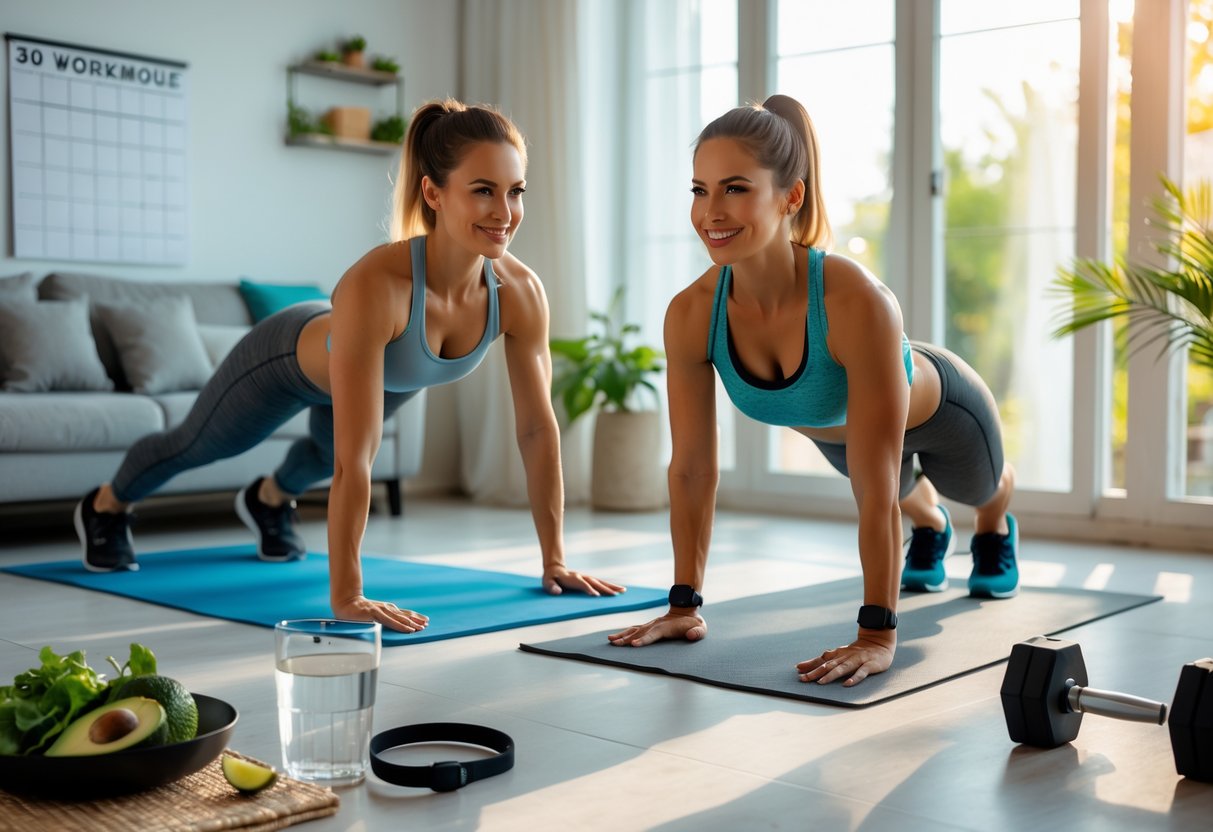
You’ll also find tips for using the keto diet to support your goals, so you can boost fat loss and muscle growth at the same time.
Each part of this guide will show you the best routines, from warm-ups and full body workouts to key moves like squats and push-ups.
You will get simple instructions for meal planning and staying on track, plus strategies to keep up your motivation, even when it gets tough.
Ready to personalize your nutrition? Try Keto Creator for a custom keto plan based on your body and goals.
Key Takeaways
- Simple, effective workouts to burn fat and build muscle at home
- Practical guidance on staying consistent and reaching your goals
- Keto diet tips to help you support your fitness journey
How 30 Day Workout Challenge Works
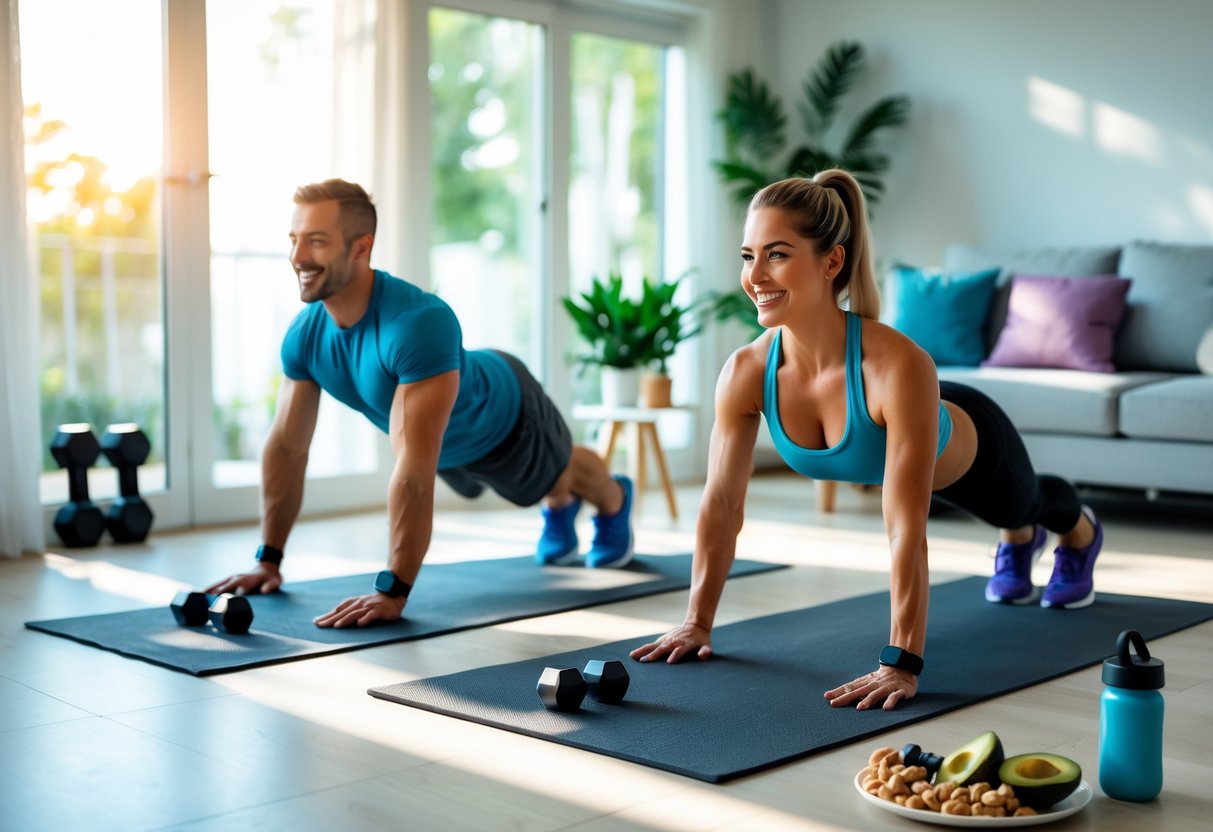
This 30-day fitness challenge uses a mix of strength training, cardio, and HIIT routines to help you burn fat and build muscle.
You can do the workouts at home with little or no equipment, while tracking your workouts helps you stay consistent and see progress.
Structure and Progression
The challenge is split into daily workouts, each focusing on different muscle groups and goals.
You’ll alternate between days that emphasize strength training and days designed for cardio or HIIT to keep your body guessing and active.
A simple weekly schedule might look like this:
| Day | Focus |
|---|---|
| Monday | Full body HIIT |
| Tuesday | Upper body |
| Wednesday | Cardio |
| Thursday | Lower body |
| Friday | Full body |
| Saturday | Active rest |
| Sunday | Rest or light movement |
Each week, you increase intensity or reps for certain moves.
This gradual progression helps you build muscle while reducing your risk of injury.
If you’re new to working out at home, here’s a beginner-friendly guide on Beginner Workouts at Home for Busy Professionals.
Required Equipment and Setup
Most workouts in this challenge do not require gym machines.
Bodyweight exercises such as squats, push-ups, and lunges are common.
A yoga mat helps make floor work more comfortable.
For extra resistance and faster results, you can use a pair of light dumbbells or resistance bands.
Clear at least six feet of space to move safely.
Make sure you have water nearby to stay hydrated.
Good ventilation helps as well, especially during HIIT or cardio sessions.
A timer or fitness app can help keep your workouts structured and on track, especially if you’re doing interval-based exercises.
Tracking Results and Motivation
Use a printable calendar, journal, or fitness app to log your daily workouts.
Write down the exercises, sets, and any improvements you notice, such as more reps or shorter rest times.
Tracking your progress not only keeps you accountable but also shows how far you’ve come.
Take weekly photos or record body measurements to see changes that the scale might not show.
Setting short-term goals, like increasing push-ups by five in a week, can keep you motivated.
Consider sharing your progress with a friend or joining online communities for support.
Getting Started: Preparation and Goal Setting
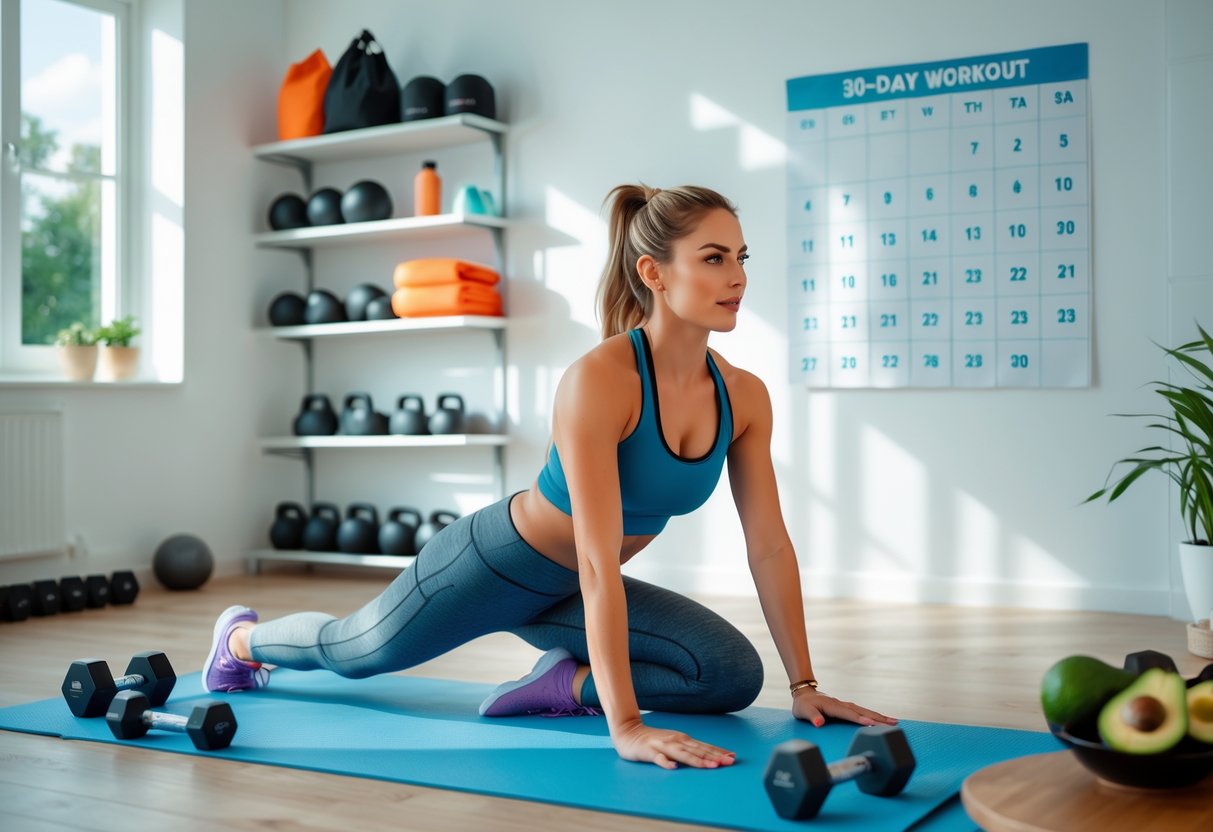
Before you begin your 30-day workout challenge at home, it’s important to know where you are now, where you want to go, and how to set up a supportive environment.
Planning ahead gives you more control over your progress and helps you stay motivated.
Setting Realistic Fitness Goals
Set clear and realistic goals to help you stay motivated.
Decide what you want to achieve, such as losing a certain amount of weight, building strength, or improving endurance.
Write your goals down and make sure they fit your lifestyle.
Pick goals that are measurable and time-bound.
For example, aiming to complete each daily workout or tracking your progress using a simple chart can help keep you focused.
Example goals:
- Work out at least 5 days a week
- Walk or jog 30 minutes daily
- Add 5 push-ups every week
Don’t compare your goals to others.
Aim for progress, not perfection.
Assessing Your Fitness Level
Check your fitness level before starting.
This helps you choose exercises that match your abilities and keep injury risk low.
Simple assessments include timing how long you can hold a plank, counting how many squats or push-ups you can do, or seeing how far you can walk in 10 minutes.
Keep a fitness journal or use a mobile app to track your results.
This way, you’ll notice even small improvements.
If you’re unsure about your health or have medical concerns, talk to your doctor first.
Listening to your body makes it easier to avoid overdoing it and encourages steady progress.
Creating Your Workout Space
Set up a space in your home that is safe, comfortable, and free from distractions.
Choose a room or area with enough space to move freely.
Remove anything that could trip you up, like loose rugs or clutter.
You don’t need fancy equipment.
A yoga mat, some water, and a towel are enough for many routines.
If you want, simple tools like resistance bands or light dumbbells can add variety.
Store your workout gear in a basket or corner so it’s always ready.
Good lighting and maybe some upbeat music can also make your exercise space more inviting.
This makes it easier to stick to your routine and finish your challenge strong.
To prevent injury and maximize results, review our guide on Beginner Workout at Home: Simple Fat-Burning Plan.
Warm-Up and Dynamic Stretches for Optimal Performance
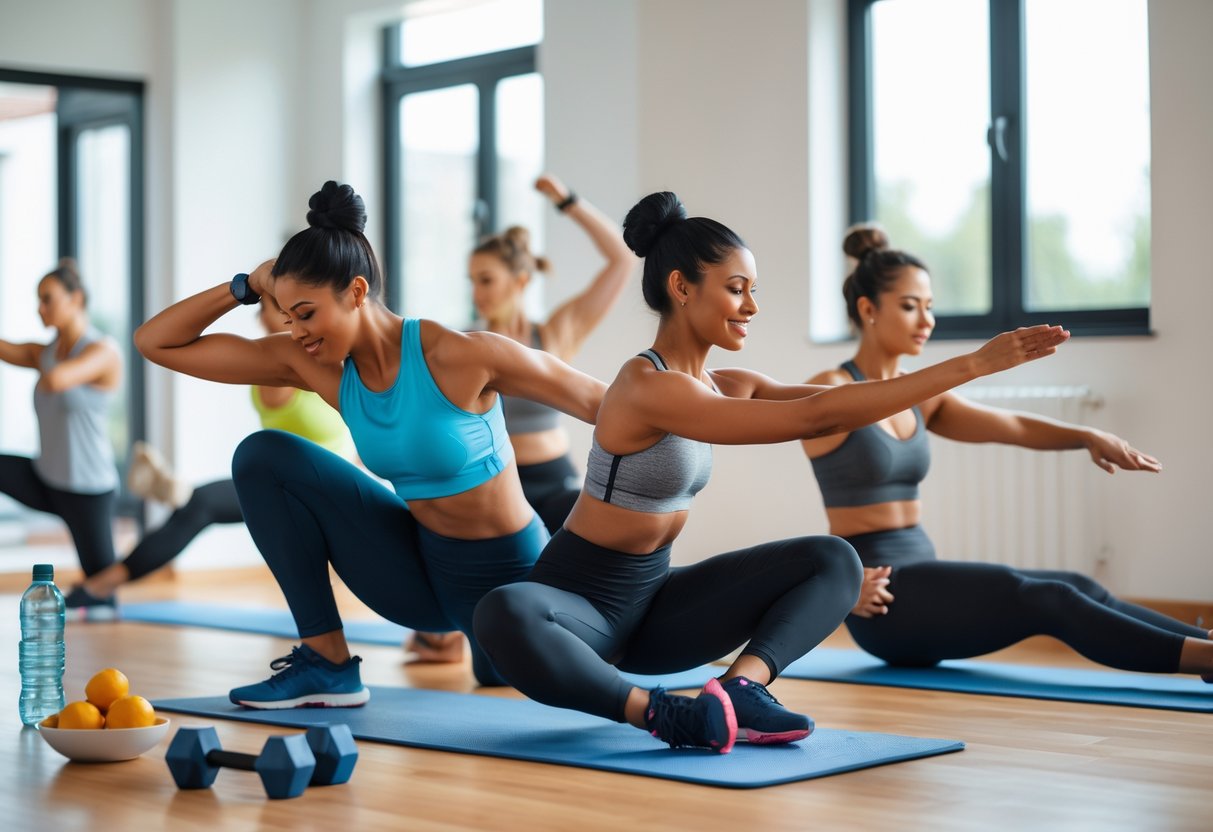
Getting ready for your workout with a warm-up and dynamic stretching is key to boosting your performance and avoiding injury.
These steps help your muscles prepare for movement, improve flexibility, and get your heart rate up safely.
Full-Body Warm-Up Routine
Start with a simple routine that uses your whole body.
This could begin with 2 minutes of brisk walking in place or light jogging to increase blood flow.
Next, move through easy movements like arm circles, shoulder rolls, and bodyweight squats.
Add hip circles and lunges to get your joints moving.
A warm-up like this helps wake up your muscles and supports balance and coordination.
Keep the pace gentle but steady.
Your body temperature should go up, and you may break a light sweat.
Dynamic Stretching Techniques
Dynamic stretches use controlled movements to get your muscles and joints ready for action.
Some good examples include:
- Leg swings (side to side and front to back)
- Walking lunges with a twist
- High knees
- Arm swings across your chest
- Torso rotations
Include 8-12 reps per move.
Focus on smooth, steady movements rather than bouncing or forcing the stretch.
Research shows dynamic stretching helps improve range of motion and can prepare your body for exercise better than static stretches.
Preventing Injury During Workouts
A proper warm-up and dynamic stretching routine makes a big difference in preventing workout injuries.
Warming up raises your muscle temperature, improving flexibility and joint function.
Dynamic stretches also boost blood supply to your muscles, which helps lower the risk of pulls or strains.
Don’t skip these steps even if you feel ready to start your workout.
Listen to your body during these movements.
If you feel pain or sharp discomfort, stop right away.
Proper warm-ups support safer, more effective workouts every time.
For joint-friendly movements, check out our post on low-impact home workouts.
Weeks 1–2: Building Foundations and Endurance
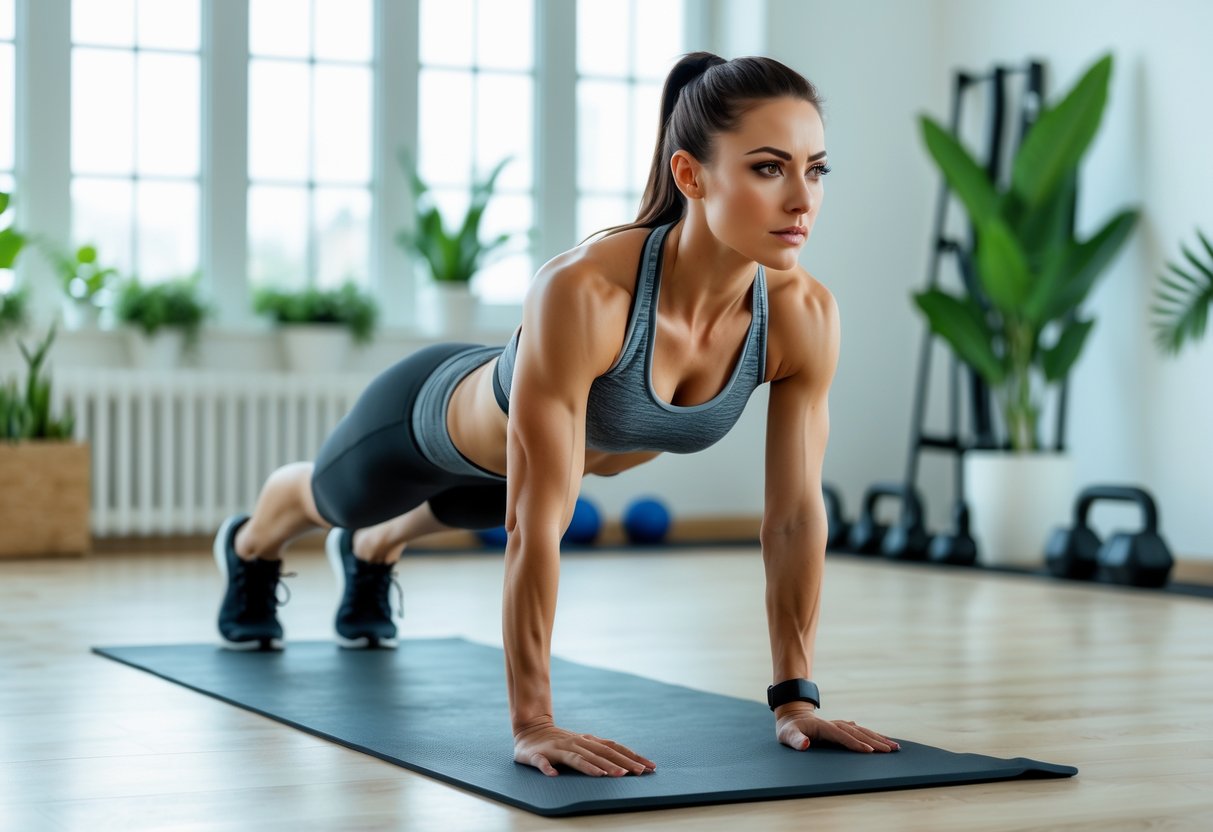
The first two weeks of your 30-day workout challenge focus on simple equipment-free moves, building your strength, and helping your body adjust to new routines.
Regular exercise, paired with smart recovery, sets up healthy habits you can actually keep.
Want to boost your metabolism try Java Burn – a powerful morning metabolism-boosting supplement.
Essential Bodyweight Exercises
Bodyweight exercises are the foundation for burning calories, building muscle, and staying consistent.
Start with these basics:
- Push-ups: Work your chest, arms, and core. If needed, do them on your knees to build up strength.
- Squats: Target your legs and glutes. Keep feet shoulder-width apart and lower down as if sitting in a chair.
- Planks: Strengthen your entire core and help with overall stability.
- Mountain climbers: Get your heart rate up and work your abs, shoulders, and legs.
Aim for 2–3 sets of 10–15 reps for each move (hold planks for 20–30 seconds).
Rest 60 seconds between sets.
Form is more important than speed—go slow to avoid injury.
These exercises are easy to do at home and do not require any equipment.
Beginner HIIT Workouts
High-Intensity Interval Training (HIIT) is a great way to burn fat and build endurance.
A typical session uses bursts of intense activity followed by short rest breaks.
Try a basic HIIT circuit:
- 30 seconds of jumping jacks
- 30 seconds of mountain climbers
- 30 seconds of air squats
- 30 seconds rest
Repeat this circuit 3–4 times.
Focus on getting your heart rate up, but never at the cost of good form.
Active Recovery Days
Recovery is just as important as training.
On alternate days, focus on gentle movement to help your muscles heal and boost flexibility.
Good options include:
- Light stretching or yoga
- Walking or easy cycling
- Mobility exercises
- Foam rolling for sore areas
Aim for 20–25 minutes of activity on these days.
Remember, it’s important to listen to your body and take extra rest if you’re feeling too sore or tired.
On active rest days, we recommend gentle stretching routines like those found in our Hyperbolic Stretching review.
Weeks 3–4: Increasing Intensity and Strength
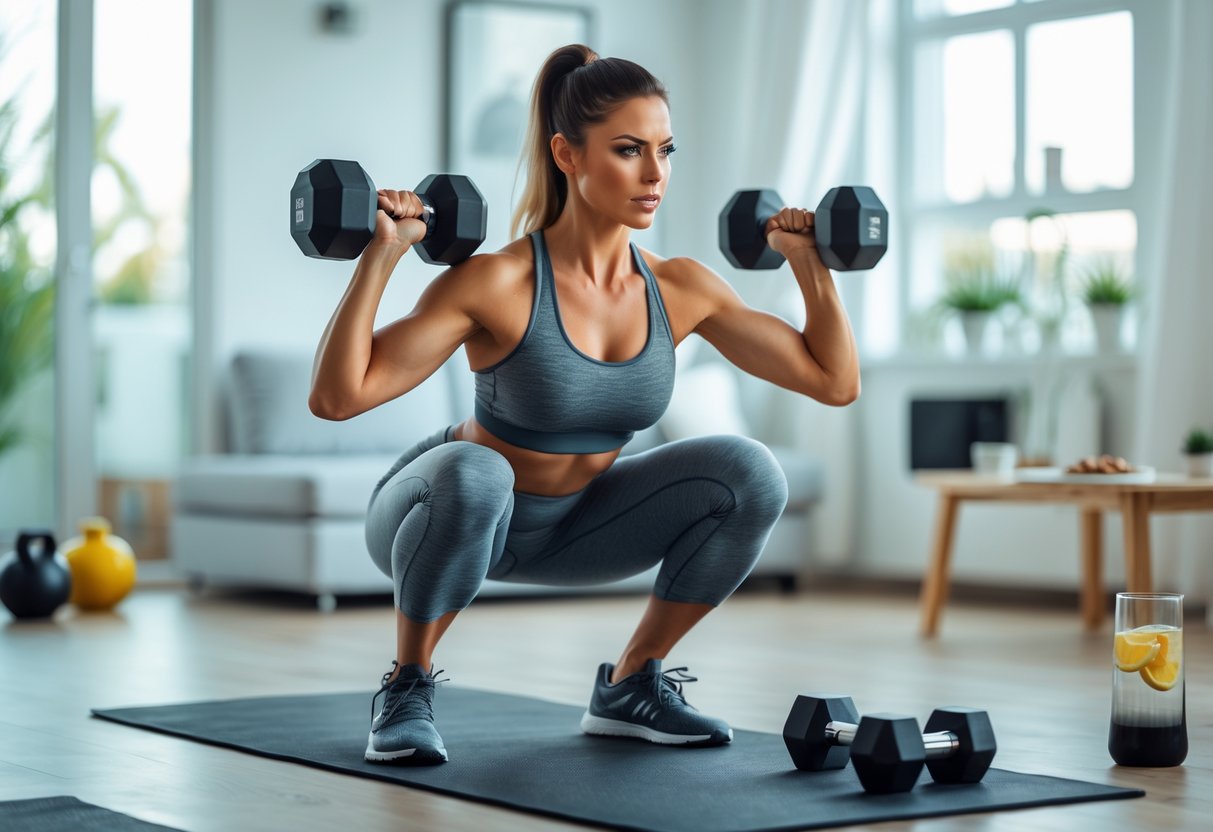
During the last two weeks of your challenge, you should focus on making each workout harder to spark more results.
This is when your workouts will use bigger movements, extra reps, and faster exercises to keep your muscles guessing and help your body change.
Progressive Overload Strategies
To stimulate continued progress, you need to challenge your muscles by increasing the demands placed on them.
The simplest way is to add more reps, increase weight, or reduce rest time between sets.
For example, if you started with 10 push-ups, try for 12-15 in Week 3.
If you have dumbbells, use a heavier set for exercises like the bent-over row or dumbbell thrusters.
No weights? Increase the tempo of bodyweight exercises or combine moves, such as adding a push-up at the top of a burpee.
Keep a written record of your reps, sets, and weights.
This helps you track your progress and sets a clear goal for each workout.
Focus on perfect form even as you increase the challenge.
Muscle-Building Circuits
Muscle-building circuits keep your heart up while also working several muscle groups at once.
In Weeks 3–4, build your circuit with 4–6 exercises like jump squats, bent-over rows, burpees, and push-ups.
Perform each move for 45 seconds, followed by 15 seconds of rest, then repeat the full circuit 3–4 times.
Here’s a sample circuit:
- 45 sec Jump Squats
- 45 sec Bent-Over Row (use dumbbells or filled water bottles)
- 45 sec Push-Ups
- 45 sec Burpees
- 45 sec Dumbbell Thrusters
- 1 min Rest
Switch up the order or add more rounds as you get stronger.
Advanced HIIT Training
High-intensity interval training (HIIT) turns bodyweight exercises into calorie-torching workouts.
For Weeks 3–4, try 30 seconds of all-out work followed by 20 seconds of rest, using moves like burpees, jump squats, and mountain climbers.
A typical advanced HIIT session can look like this:
| Exercise | Work | Rest | Rounds |
|---|---|---|---|
| Burpees | 30 sec | 20 sec | 4 |
| Jump Squats | 30 sec | 20 sec | 4 |
| Dumbbell Thrusters | 30 sec | 20 sec | 4 |
Choose 3–4 exercises and cycle through them for four rounds.
Make sure to warm up before and cool down after each session.
Need more energy for intense sessions? Try Nagano Tonic to support endurance and recovery.
Key Strength Training Moves to Build Muscle at Home
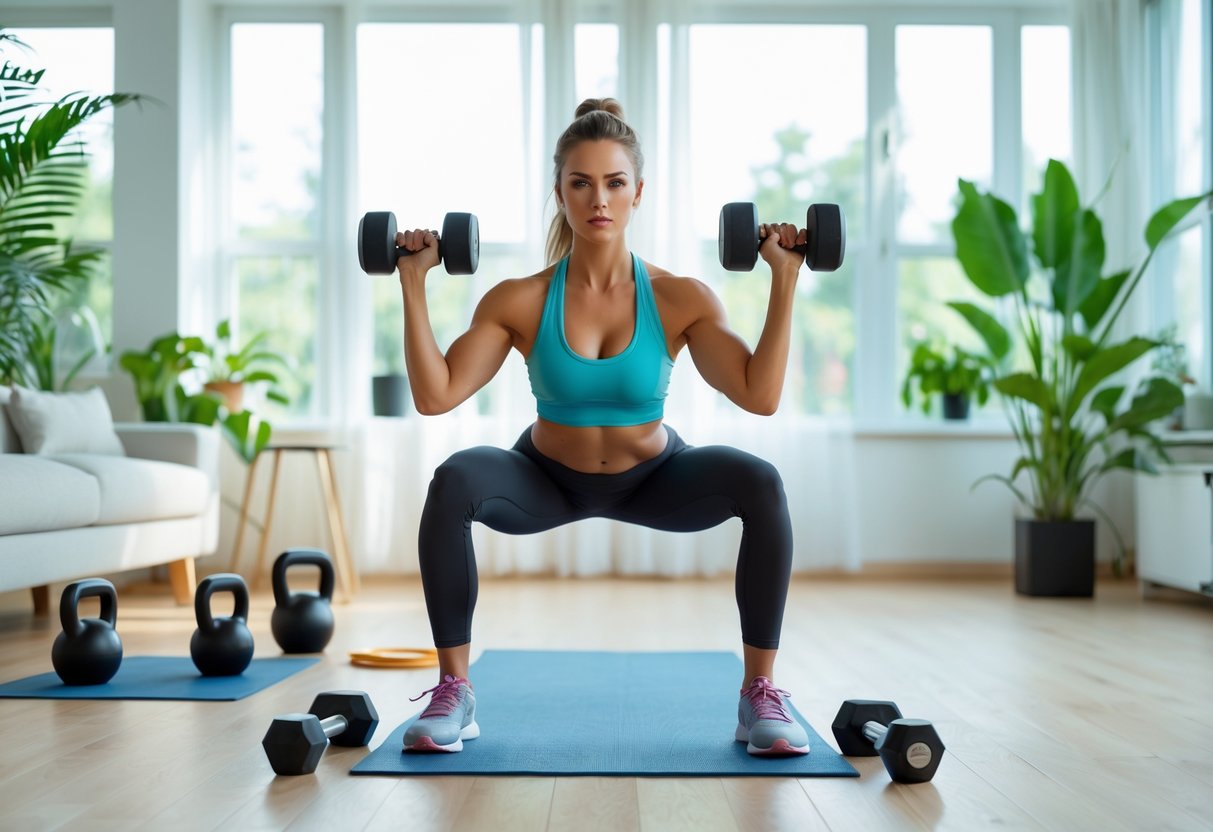
Strength training at home can help you build muscle in your legs, arms, chest, back, and core without special machines.
Using the right bodyweight or dumbbell moves gives you a complete workout and boosts fat loss.
Goblet Squats and Lower Body Strength
The goblet squat is a simple but effective move to build strength in your thighs, glutes, and calves.
You only need a single dumbbell or kettlebell.
Hold the weight at your chest, stand with feet shoulder-width apart, and squat down until your hips are lower than your knees.
Make sure to keep your chest up and heels flat on the ground.
Pushing through your heels helps activate your glutes and quads.
This move not only builds muscle, but also improves balance and stability.
Perform 3 sets of 10-15 reps, resting 60 seconds between sets.
If you don’t have weights, do bodyweight squats for similar benefits.
Goblet squats can make your legs stronger and help you get more out of workouts like jumping jacks, lunges, or step-ups.
Push-Ups and Upper Body Compound Exercises
Push-ups are one of the most important bodyweight exercises for your chest, shoulders, triceps, and core.
Start in a plank position with hands just wider than shoulder-width.
Lower your body until your chest is close to the floor, then press back up.
Keep your body in a straight line from head to heels, and avoid letting your hips sag.
There are simple ways to modify: use your knees to make it easier or raise your feet to make it harder.
Add in bent-over rows with dumbbells or a filled backpack to work your back and biceps.
For bent-over rows, bend your knees slightly, hinge forward at the hips, and pull the weight toward your lower ribs.
Aim for 3 sets of 10-12 reps each.
Planks and Core Stability
Planks are a key move for core strength and stability.
They work your abs, lower back, shoulders, and even your glutes.
Get into a push-up position, but rest your weight on your forearms instead of your hands.
Keep your body in a straight line and tighten your stomach.
Hold the plank for 20-40 seconds, building up as you get stronger.
Do 3 sets with 30-60 seconds rest between.
For more challenge, try side planks or add gentle leg lifts.
Strong core muscles support your spine and make it easier to perform squats, push-ups, and other moves safely.
Looking for strength training program? Read our guide on Strength Training for Women Program: Beginner’s 4-Week Guide with Keto Tips.
Fat-Burning HIIT and Cardio Workouts
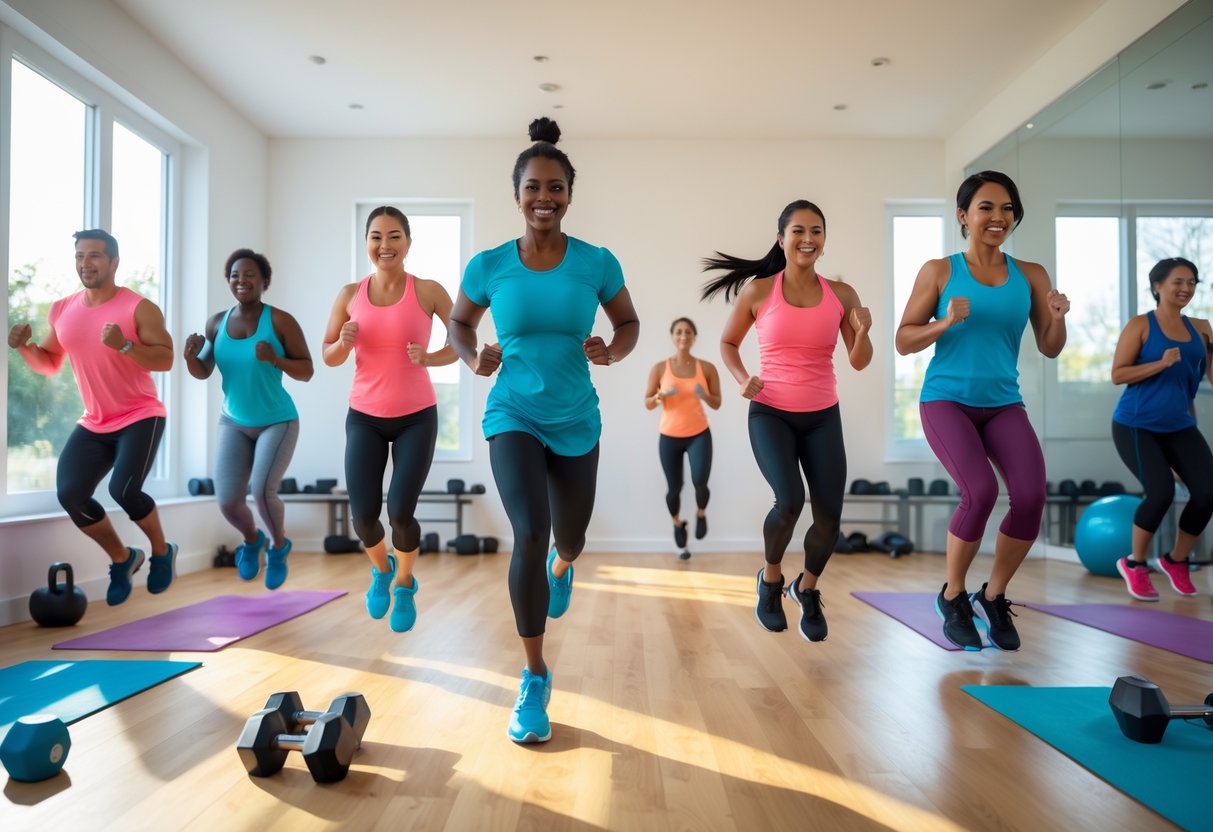
If you want to get the best results at home, focus on high-intensity workouts that mix strength and cardio.
These routines use your body weight, require little space, and burn calories quickly while building muscle.
Burpees and Explosive Movements
Burpees are one of the most effective fat-burning exercises.
Each rep combines a squat, jump, and push-up, working your arms, chest, core, and legs.
You move through these stages quickly, which keeps your heart rate up and boosts calorie burn.
Explosive moves such as jump squats and jumping lunges add variety to your routine.
These exercises increase your power and speed, while also strengthening your glutes, quads, and calves.
Try this circuit:
Sample HIIT Circuit (Repeat 3 Rounds):
- 10 Burpees
- 12 Jump Squats
- 10 Jumping Lunges per leg
- Rest 30 seconds
Perform these moves with full effort during the work period and rest in between.
Mountain Climbers and Plank Jacks
Mountain climbers target your core, shoulders, and legs, while giving you a strong cardio workout.
You start in a plank and move your knees toward your chest fast, like a sprint on the floor.
This keeps your body engaged and helps burn fat.
Plank jacks are a dynamic variation of the classic plank.
By jumping your feet in and out, you challenge your abs and stabilizer muscles even more.
Add these moves together for a simple yet tough interval round:
Sample Combo:
- 30 seconds mountain climbers
- 20 seconds plank jacks
- 10 seconds rest
- Repeat 4-5 times
Keep your movements quick but under control to avoid losing good form.
High-Intensity Full-Body Intervals
Full-body HIIT intervals push every muscle and keep your heart rate high.
You mix a series of compound exercises in quick rounds, with short breaks.
This method helps you lose fat and build muscle at once.
Examples of full-body intervals include alternating:
- Push-ups
- Squat jumps
- High knees
- Plank holds
Rotate between these for 30 seconds each, then rest for 30 seconds after one round.
Repeat 3–5 times.
Focus on maximum effort during each move, but never sacrifice form.
High-intensity circuits like these have shown strong results for burning fat in a HIIT Home Workout without needing any equipment.
Combine high-intensity training with Tea Burn – a simple metabolism-boosting tea for faster results.
Core-Focused Circuits for Definition and Stability
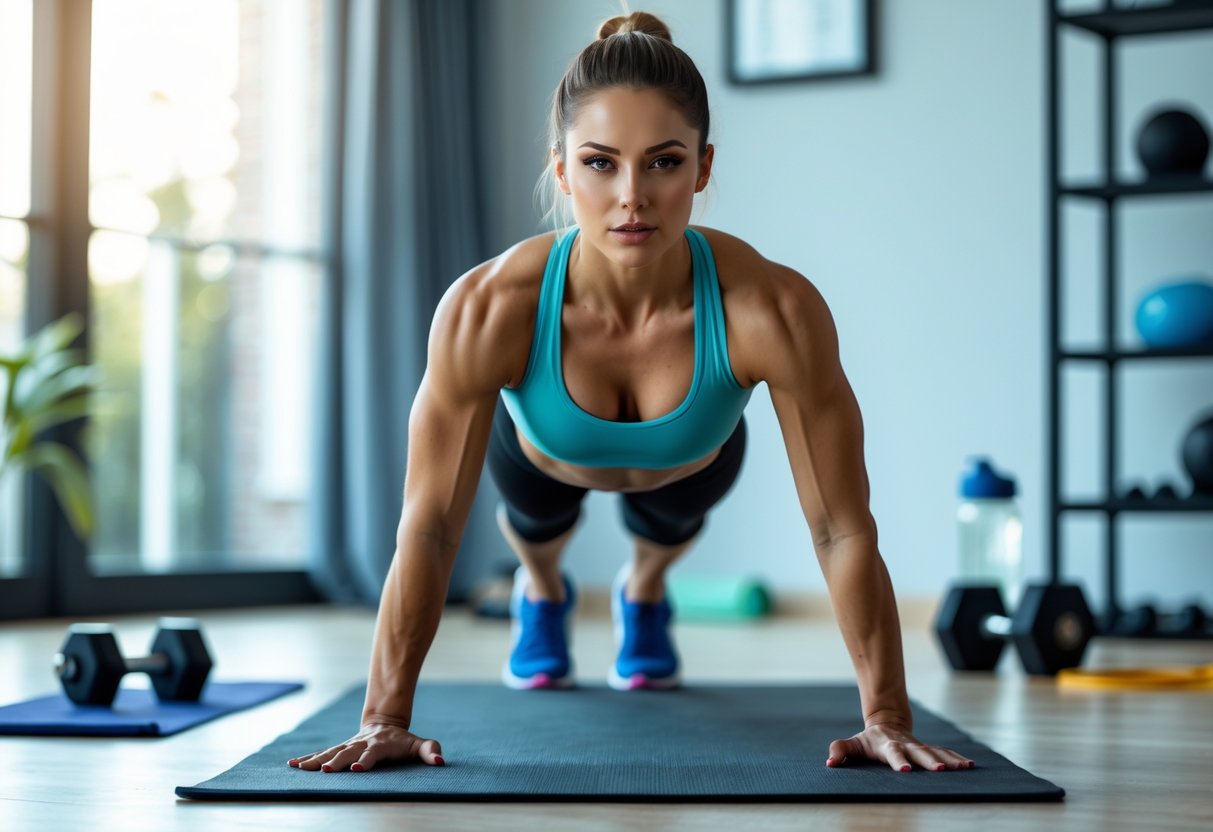
Training your core at home builds muscle, helps with balance, and can improve your everyday strength.
Mixing up your movements targets different parts of your abs and supports your lower back.
Russian Twists and Sit-Ups
Russian twists and sit-ups are two simple but effective exercises to work your core from different angles. Sit on the floor with your knees bent for Russian twists.
Hold your hands together or grab a small weight. Twist your chest and arms from side to side, tapping each side of the floor with your hands.
This move works your obliques, the muscles on the sides of your waist. Performing controlled twists, about 15-20 reps per set, helps you feel the muscles working.
Sit-ups, when done with good form, strengthen the upper and lower abs. Lie flat, bend your knees, and cross your arms over your chest.
Focus on lifting your shoulders off the ground without pulling on your neck.
Here’s a quick circuit you can try:
| Exercise | Reps | Rest |
|---|---|---|
| Russian Twists | 20 | 20 seconds |
| Sit-Ups | 15 | 20 seconds |
| Repeat x3 |
Plank Variations
Planks build both strength and stability in your core. You can perform them on your elbows or hands.
Standard planks work the front of your abs. Adding movement or changing your position will hit more muscles.
Try these plank variations:
- Side Plank: Supports your body on one arm, strengthening your obliques.
- Plank with Shoulder Tap: In plank position, tap your right hand to your left shoulder and switch. This challenges your balance.
- Plank Hold: Hold for up to 1 minute, keeping your back flat and abs tight.
Full-Body Core Activation
Engaging your core doesn’t mean only doing ab exercises. Many full-body moves also help build core strength.
Mountain climbers, burpees, and dead bugs are good examples. These exercises force your abs to work while your arms and legs move.
For mountain climbers, start in a plank and drive your knees to your chest one at a time. Dead bugs work your deep abs: Lie on your back, arms up, and slowly lower opposite arm and leg toward the ground, then switch.
By adding these moves into your routine, you target your core while also burning more calories.
You can find functional, core-focused circuits that boost muscle and endurance at home in programs like this Abs Home Workouts for a Toned Core.
Active Recovery and Rest Strategies
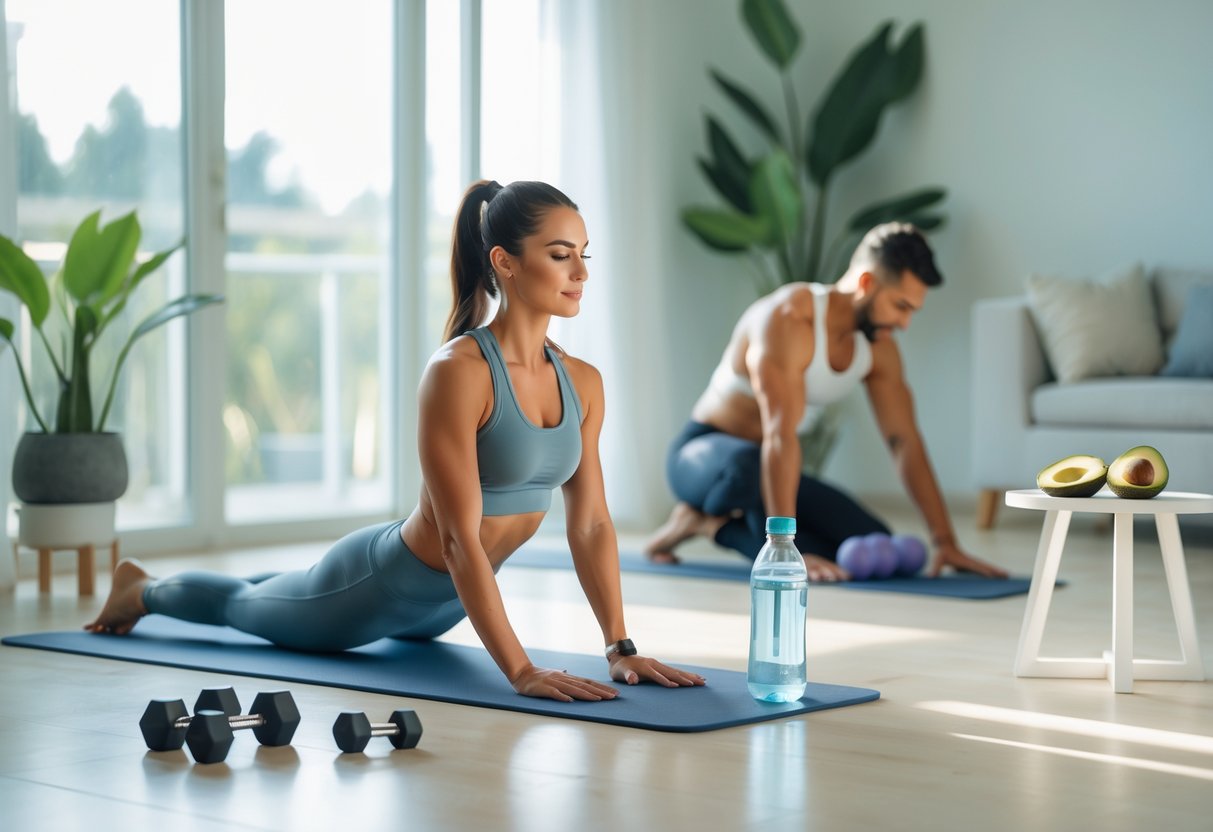
Planning for recovery days helps your body heal and prevent injury. These strategies keep your muscles strong and support fat loss by managing soreness and improving how well you move.
Importance of Active Recovery
Active recovery means doing light exercises instead of complete rest. On these days, you keep moving with low-impact activities like walking, gentle cycling, or yoga.
This keeps your blood flowing so muscles get the nutrients they need to repair and grow. It can also help ease muscle soreness and stiffness after intense workouts.
Studies show that active recovery days can actually help you perform better during workouts in the long run. Active recovery days should feel easy—think about activities that leave you refreshed, not tired.
Dynamic Stretch Sessions
Dynamic stretches are controlled, gentle movements that warm up your muscles. These stretches help get your body ready for movement by increasing heart rate and blood flow.
Good examples include arm circles, leg swings, and hip circles. You should do these for about 5–10 minutes before your home workouts or on your active recovery days.
Doing dynamic stretches can make a big difference, lowering injury risk and helping muscles move smoothly.
A simple routine might look like:
- Arm Circles: 20 seconds each direction
- Leg Swings: 15 swings per leg
- Hip Circles: 10 circles each direction
Dynamic stretching is different from static stretching because you are moving as you stretch, which wakes your body up and boosts flexibility.
Flexibility and Mobility Work
Flexibility and mobility work focus on improving your range of motion and joint health. Flexibility usually means stretching muscles, while mobility includes exercises that move your joints through their full range.
You can use routines with static stretches like holding a hamstring or quad stretch for 20–30 seconds. Good mobility exercises include deep bodyweight squats or shoulder rolls.
Adding a few minutes of these at the end of your workout or on a rest day will help you recover faster and move more easily in your next session.
This kind of training also supports muscle health, reduces tightness, and helps prevent injuries that can happen from stiff muscles or joints.
Want to make the most of your recovery days? Try Hyperbolic Stretching – a proven 8-minute method to boost flexibility and accelerate fat loss. It’s perfect for active recovery and improving performance over time.
Staying on Track: Motivation and Consistency Tips
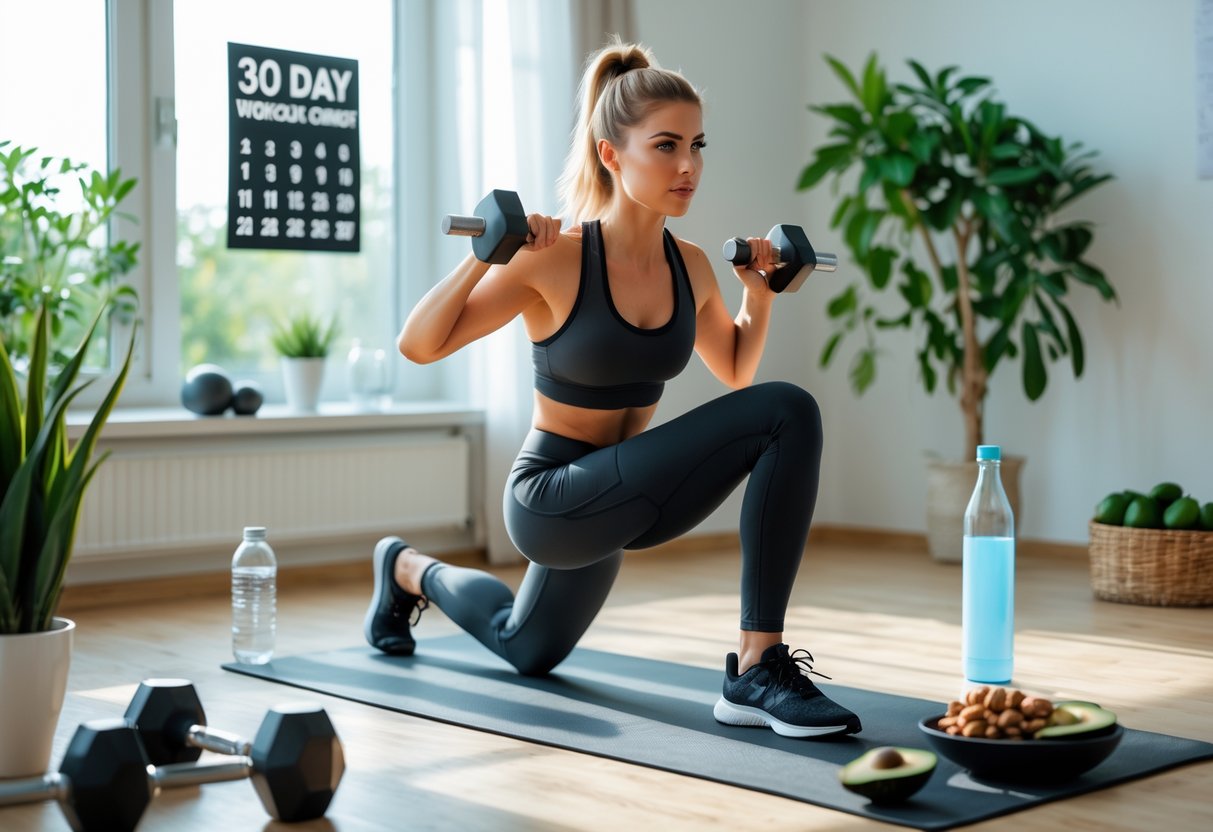
Keeping a routine for 30 days can be challenging, but with smart planning, you can stay driven and see real changes. Building strong habits, pushing through slow periods, and keeping an eye on your progress will set you up for success.
Developing Lasting Habits
Consistency is crucial for results. Set a specific time for your workouts each day, such as right after waking up or before dinner.
Treat it like any important appointment. Laying out your workout clothes the night before helps remove excuses in the morning.
Choose workouts you enjoy. If you dislike your plan, you are less likely to stick with it.
Try short, effective routines that fit your schedule so you do not feel overwhelmed. Reward yourself for meeting weekly workout goals.
Small rewards, like a relaxing bath or new workout gear, can make a big difference. When workouts become a normal part of your day, they get easier to maintain.
Overcoming Plateaus
You may notice your progress slowing or stopping. This is called a plateau.
It is common, especially in the middle of a challenge. To beat a plateau, change up your routine every week.
Try switching the order of your exercises or increasing the number of sets and reps. Focus on both strength and cardio.
Adding new moves like lunges or plank variations can help your body adapt and push past barriers. Give yourself permission to rest when you need it.
Taking a short break or adding a rest day will help your muscles recover and come back stronger. Stay patient.
Plateaus are temporary. If you keep adjusting your plan and put in the effort, your results will improve again.
Tracking Progress Over 30 Days
Keeping track of your progress helps you see how far you’ve come and keeps you motivated. Write down each workout in a notebook or a phone app.
Record the number of reps, sets, or how long you completed each exercise. Take weekly progress photos and simple measurements, like waist or arm size.
These changes might be small, but when you look back after 30 days, you will notice the difference. A table can help keep your progress organized:
| Day | Workout Done | Sets/Reps | Notes/Feelings |
|---|---|---|---|
| 1 | Full body | 3×12 | Felt strong, sweaty |
| 7 | Cardio | 30 min | Tough, but finished |
| 14 | Upper body | 4×10 | Arm strength better |
Keto Tips to Maximize Fat Loss and Muscle Building
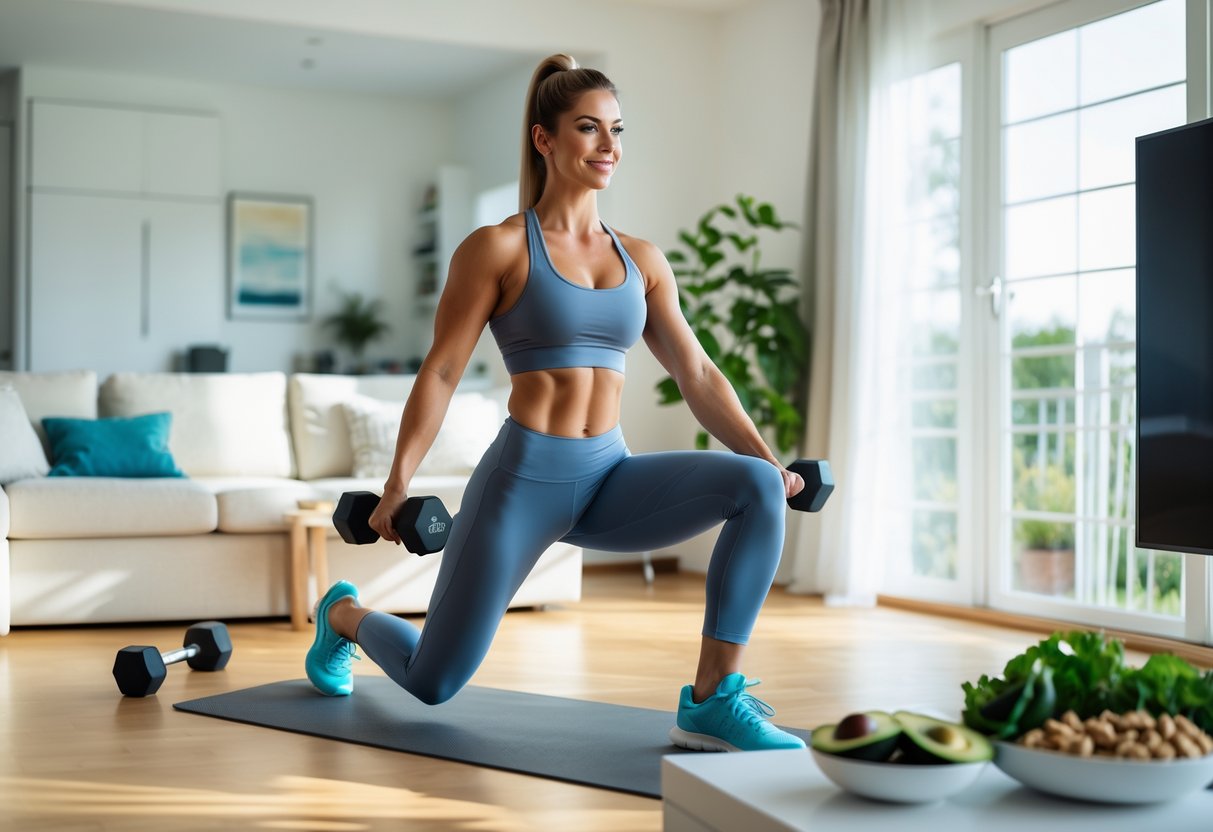
Eating fewer carbs while upping your protein and healthy fat can help you burn body fat and gain lean muscle. Doing this along with a consistent workout routine can increase your results.
Understanding the Ketogenic Diet
A ketogenic diet is a low-carb, high-fat eating plan. You usually limit your daily carbs to 20-50 grams.
This low level of carbs makes your body switch from using glucose for energy to burning fat. The process is called ketosis.
In ketosis, your body breaks down stored fat into molecules called ketones. These become your main fuel source.
This can help you lose fat without losing muscle if your protein intake is high enough. For good results, quality fats like olive oil, avocado, and nuts are important.
You should also eat protein-rich foods such as eggs, chicken, and fish. This helps repair and grow muscles during your fitness challenge.
If you’re new to keto, explore our Beginner’s Guide to the Ketogenic Diet.
Integrating Keto with Home Workouts Challenge
Building muscle on keto is possible if you pay attention to your food and your workouts. Focus on strength training along with cardio.
Push-ups, squats, lunges, and core exercises use your body weight to build muscle at home. You need to keep your protein high to protect the muscle you have and support new muscle growth.
Choose workouts with big movements like squats and presses. These recruit more muscle groups and send signals to your body to grow stronger.
Stay hydrated, and get enough salt and minerals. Some people feel tired when starting keto.
Sample Keto Meal Ideas
Breakfast: Scrambled eggs cooked in butter with avocado slices on the side. Pair with a handful of spinach.
Lunch: Grilled chicken salad with olive oil dressing, mixed greens, and nuts. You can add feta cheese for extra flavor.
Snack: Celery sticks with almond butter, or cheese cubes.
Dinner: Salmon baked with broccoli and olive oil. Add cauliflower rice as a filling, low-carb side.
Get your tailored keto blueprint with Keto Creator – built for your exact needs.
Frequently Asked Questions
You can lose fat, gain muscle, and keep good habits by following clear workout plans and using smart nutrition strategies like the keto diet.
Staying organized, keeping things simple, and having access to reliable resources will make it easier to succeed with your at-home fitness goals.
What is an effective 30-day workout plan for fat loss at home?
A good 30-day workout plan for fat loss should mix cardio and strength training.
Exercises like squats, lunges, push-ups, and jumping jacks can be done with no equipment.
Focus on moving most days of the week and keep your rest days active with light stretching or walking.
The goal is to keep your heart rate up while also building muscle.
How can I build muscle with a 4-week home workout challenge?
To build muscle in a month, use bodyweight moves such as planks, dips, squats, and lunges.
Increase repetitions or add sets weekly to make the workouts harder.
Try to exercise different muscle groups on different days for balanced development.
You can add dumbbells or other weights if you have them, but you can still get results with just your body weight.
What are some keto diet tips to enhance a workout challenge for weight loss?
When combining keto with a workout, eat enough protein from foods like eggs, fish, or chicken to help your muscles recover and grow.
Choose healthy fats such as olive oil, nuts, and avocados.
Stay hydrated, as keto can make you lose water quickly.
Keep your carb intake low, but eat leafy greens and non-starchy veggies.
Avoid processed foods, and pay attention to how your body feels during workouts.
Can you suggest a 21-day exercise regimen for effective weight loss?
A 21-day plan can include a mix of high-intensity interval training (HIIT), bodyweight strength exercises, and active rest days.
Do workouts like squats, push-ups, planks, and jumping jacks two or three days in a row, then take a day to walk or stretch.
Repeat this cycle for three weeks, gradually increasing your effort level.
What are the essentials for staying on track with a home workout challenge?
Set clear goals and pick a time each day for your workout.
Keep your plan simple and post it somewhere you can see.
Track your progress on a calendar or in an app.
Find workouts you enjoy to stay motivated.
If you miss a day, get back to it the next day—consistency matters more than being perfect.
Planning your meals and having healthy snacks ready can also help.
Conclusion
You have the tools to complete a 30-day workout challenge right at home.
With dedication and smart planning, you can build muscle, burn fat, and improve your fitness.
Keep each session short and focused.
Even on busy days, a simple 20-minute HIIT routine from a 30-day HIIT challenge can deliver strong results.
Track your progress by noting reps, weights, or workout times.
Use a daily log or app to help you see commitment build into real changes.
If you want to follow keto tips, focus on high-quality proteins, healthy fats, and plenty of non-starchy vegetables.
Pairing the right nutrition with exercise supports your strength and goals.
- Schedule workouts in advance
- Stick to your meal plan
- Rest when needed for muscle recovery
- Stay hydrated
You can adjust workouts to match your fitness level.
Start at your own pace, and challenge yourself when ready.
Whether you train morning or evening, don’t forget to fuel fat loss with Java Burn or Tea Burn for an added metabolic edge.
